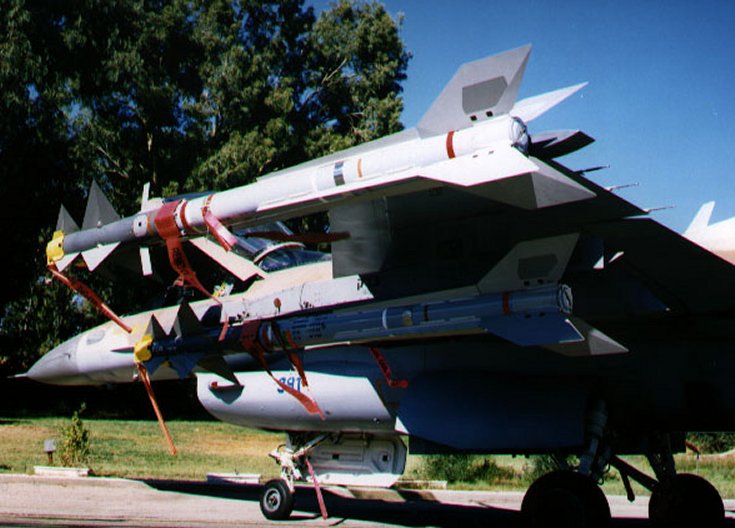Fighter Jet News
F-16 Fighting Falcon News
USAF to purchase 20 Python 5 missiles
November 7, 2006 (by
Lieven Dewitte) -
US defense news magazine "Defense News" reports that the US Air Force might buy twenty Python 5 Full Sphere air-to-air missiles from Rafael, for an F-16 fighter squadron stationed at Nevada.
Should the negotiations lead to a contract, this would actually be the first time that the US Air Force has purchased air-to-air missiles from a foreign manufacturer.
Over the years, the Pentagon has purchased air-to-surface missiles for fighter aircraft in the US Air Force and Navy from foreign manufacturers, including AGM-142 Popeye/Have Nap missiles from Israel, BLU-107 Durandal missiles from France, and AGM-119 Penguin missiles from Norway.
The Python 5 is currently the most capable short-range AAM in Israel's inventory. It has BVR (beyond visual range), LOAL (lock-on after launch), and all-aspect, all-direction (including backward) attack capability. The missile has an advanced electro-optical imaging seeker that scans the target area for hostile aircraft, then locks-on for terminal chase.
Only last summer, the Python 5 scored its first combat kill when an Israeli F-16 shot down a Hizbollah UAV off the coast.
The Python 5 is quite revolutionary. New technologies implemented in the Python 5 give it maneuvering and launching skills unimaginable just few years ago. Instead of talking about certain "killing hemisphere" we are talking about an ability to shoot any target at any angle, including backwards launch. This ability is possible by applying LOAL (lock on after launch) technology. As opposed to LOBL (lock on before launch), that is used in all short range air-to-air missiles (excluding the Python 5 of course) in LOAL mode the pilot can launch a missile without being locked on the target, by getting the aircraft's estimated location from an array of sensors deployed on the launching aircraft.
From the moment the Python 5 is launched, its head seeker scans the designated area constantly while it flies in a direct path to the estimated location of the target. Once the missile "sees" the target, it employs its unique, first of its kind, electro-optical head-seeker and locks on the target. Then the missile switches to a close hunt combat which holds no future to the target aircraft.
Conventional air-to-air missiles see targets as dots - a fact which makes it hard for the missile to tell between true or false targets. The Python 5's head seeker literally sees a clear image of the target and background, giving it an incredible advantage over other missiles by authenticating the target, thus reducing the chance of being mislead by counter measures. Using this technology allows the luxury of locking on a target after the launch.
Another key element of the super advanced Python 5 is its computer system. In order to support its sophisticated head-seeker, the engineers had to fit a great amount of computing power into the missile. In fact, the computer of the Python 5 requires a hundred times more computing power than the one installed in the Python 4.
Over the years, the Pentagon has purchased air-to-surface missiles for fighter aircraft in the US Air Force and Navy from foreign manufacturers, including AGM-142 Popeye/Have Nap missiles from Israel, BLU-107 Durandal missiles from France, and AGM-119 Penguin missiles from Norway.
The Python 5 is currently the most capable short-range AAM in Israel's inventory. It has BVR (beyond visual range), LOAL (lock-on after launch), and all-aspect, all-direction (including backward) attack capability. The missile has an advanced electro-optical imaging seeker that scans the target area for hostile aircraft, then locks-on for terminal chase.
Only last summer, the Python 5 scored its first combat kill when an Israeli F-16 shot down a Hizbollah UAV off the coast.
The Python 5 is quite revolutionary. New technologies implemented in the Python 5 give it maneuvering and launching skills unimaginable just few years ago. Instead of talking about certain "killing hemisphere" we are talking about an ability to shoot any target at any angle, including backwards launch. This ability is possible by applying LOAL (lock on after launch) technology. As opposed to LOBL (lock on before launch), that is used in all short range air-to-air missiles (excluding the Python 5 of course) in LOAL mode the pilot can launch a missile without being locked on the target, by getting the aircraft's estimated location from an array of sensors deployed on the launching aircraft.
From the moment the Python 5 is launched, its head seeker scans the designated area constantly while it flies in a direct path to the estimated location of the target. Once the missile "sees" the target, it employs its unique, first of its kind, electro-optical head-seeker and locks on the target. Then the missile switches to a close hunt combat which holds no future to the target aircraft.
Conventional air-to-air missiles see targets as dots - a fact which makes it hard for the missile to tell between true or false targets. The Python 5's head seeker literally sees a clear image of the target and background, giving it an incredible advantage over other missiles by authenticating the target, thus reducing the chance of being mislead by counter measures. Using this technology allows the luxury of locking on a target after the launch.
Another key element of the super advanced Python 5 is its computer system. In order to support its sophisticated head-seeker, the engineers had to fit a great amount of computing power into the missile. In fact, the computer of the Python 5 requires a hundred times more computing power than the one installed in the Python 4.
Related articles:
Forum discussion:
Tags
- First combat kill with Python 5 (2006-09-17)
- Rafael introduces Python 5 - Full Sphere AA missile (2003-07-12)
- Israel's missile agreement (1998-05-24)
- F-16 Fighting Falcon news archive
Forum discussion:
- USAF to purchase 20 Python 5 missiles ( 4 replies)
Tags

